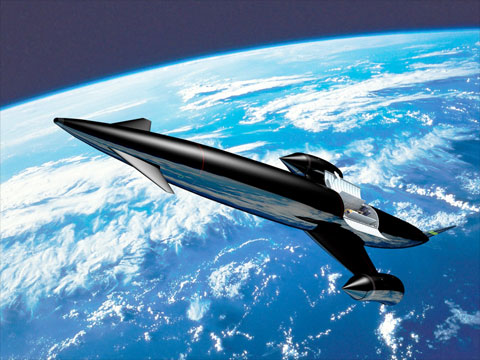The Rocket That Thinks It's A JetThe SKYLON spaceplane is one step closer to realization thanks to European Space Agency and UK Government support for revolutionary British propulsion technology.
A reusable spaceplane that can take off from a conventional aircraft runway, carry over twelve tonnes to orbit and then return to land on the same runway could be less than a decade away thanks to a one million euro award by the European Space Agency (ESA).
The contract awarded to Reaction Engines Limited (REL), is part of a joint public and private multi-million pound development programme, that will demonstrate the core technologies for the SABRE air-breathing rocket engine, which will power the SKYLON spaceplane.

Lord Drayson, Minister for Science and Innovation, said:
"This is an example of a British company developing world beating technology with exciting consequences for the future of space. It is fantastic that Reaction Engines, the British National Space Centre and ESA have successfully secured this public-private partnership arrangement and I look forward to seeing how the project progresses."
The SABRE is a unique hybrid engine that can "breathe" air when in the atmosphere, like a jet engine, and become a rocket engine when in space. In air-breathing mode air is first cooled by a revolutionary heat exchanger pre-cooler before being compressed and fed to the rocket engine to be burned with hydrogen fuel. When in rocket mode the hydrogen is burnt with liquid oxygen.
Alan Bond, Managing Director of REL, said: "Traditional throw-away rockets costing more than a $100 million per launch are a drag on the growth of this market. The Holy Grail to transform the economics of getting into space is to use a truly reusable spaceplane capable of taking off from an airport and climbing directly into space, delivering its satellite payload and automatically returning safely to Earth.
"Years of planning and research by REL on the SKYLON vehicle and its unique SABRE engine mean that we have an inside track on realising this goal. SKYLON could reduce the cost of getting into space by a factor of ten and improve the reliability by a thousand."
The demonstration programme has the objective of removing all the outstanding technical concerns on the SABRE engine. This will pave the way to a full engine development programme as part of the overall development of SKYLON. Cheap, easy and reliable access to space is critical to the development of the global space market, now worth more than $150 billion a year worldwide.
The demonstration programme will look at three key areas in the engine.
The first area, conducted by REL, concerns the revolutionary precooler that cools the incoming air as it enters the engine. During the programme a test precooler will be constructed using the actual module design for the flight engines. This will be tested on the company's B9 jet engine experimental facility at Culham in Oxfordshire.
The second area is the cooling of the combustion chamber, where the propellants are mixed and burnt producing water vapour at around 3,000oC. The SABRE engine uses the air or liquid oxygen as the cooling fluid - a key and unusual design feature as most rocket engines use the hydrogen fuel for cooling instead. EADS Astrium and DLR in Germany will be conducting this work using demonstration chambers fired at the DLR Lampoldhausen facility.
The third area, led by the University of Bristol, will explore advanced exhaust nozzles that can adapt to the ambient atmospheric pressure. This follows on from the successful STERN (Static Test of ED Rocket Nozzle) test rocket programme that was conducted last year. As part of the ESA contract a new water cooled chamber will be constructed and test fired.












